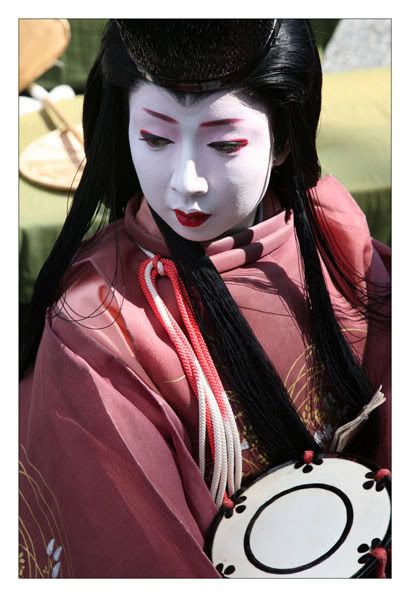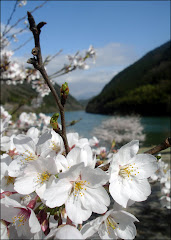Lady Shizuka is one of the most famous and celebrated women of Japanese history. Daughter of a shirabyoshi, or court dancer, Shizuka recieved an invitation from the retired Emperor Shirakawa to dance for the gods, hoping that it would bring an end to a long drought. The chants of a hundred Buddhist monks performances by ninety-nine shirabyoshi had proven useless, but Shizuka's graceful movements acheived the desired effect. The Emperor praised her performance, and it was then that she met the hero Minamoto-no-Yoshitsune.
As a brilliant Genji general in the Gempei War (1180-1185), Yoshitsune's success earned him the distrust of his half-brother, Yoritomo, leader of the Genji clan. In 1185, Yoritomo forced his half-brother to flee and live like an outlaw. Four years later, he was betrayed, and forced to commit seppuku (ritual suicide).

Terukoma waits patiently as stylists make a few last minute touch-ups to her carefully styled wig. She holds a tsuzumi, an hourglass-shaped drum originally taught with fox skin. Played with the tips of the fingers over the shoulder, it produces a distinct "pon" sound. The tsuzumi is used in classical Noh and Kabuki theater and is one of the many traditional instruments studied by geiko and maiko.
Shizuka, pregnant with his child, was captured by Yoritomo. Forced to dance for him, he was so charmed that he agreed to spare her life and that of her unborn child-- if it was a girl. Unfortunately, she gave birth to a son, who was soon killed at Yoritomo's order to prevent the child from seeking vengeance for his father's death later in life. Some say that Shizuka was also killed, some that she became a nun, and others that she drowned herself in a river in despair. She has haunted Japanese art and literature, appearing in everything from Kabuki to manga, ever since.





1 comment:
That first picture - kirei!
Wish you were here...
Post a Comment